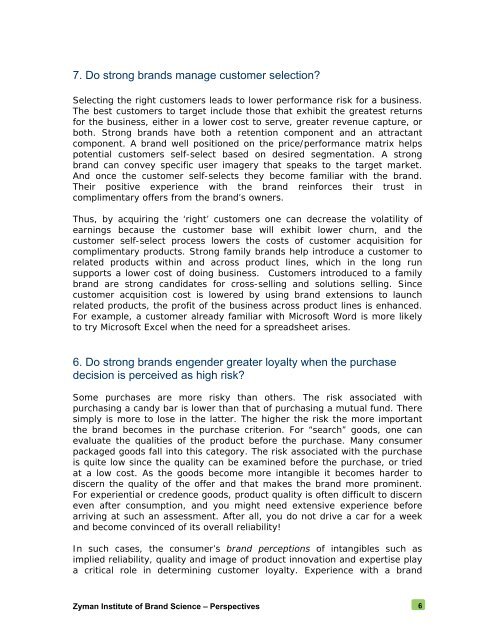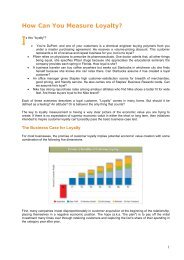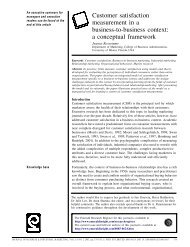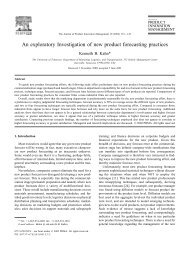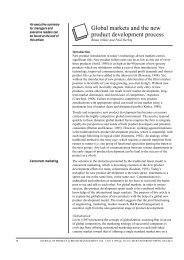The Executive's Guide to Branding
The Executive's Guide to Branding
The Executive's Guide to Branding
Create successful ePaper yourself
Turn your PDF publications into a flip-book with our unique Google optimized e-Paper software.
7. Do strong brands manage cus<strong>to</strong>mer selection?<br />
Selecting the right cus<strong>to</strong>mers leads <strong>to</strong> lower performance risk for a business.<br />
<strong>The</strong> best cus<strong>to</strong>mers <strong>to</strong> target include those that exhibit the greatest returns<br />
for the business, either in a lower cost <strong>to</strong> serve, greater revenue capture, or<br />
both. Strong brands have both a retention component and an attractant<br />
component. A brand well positioned on the price/performance matrix helps<br />
potential cus<strong>to</strong>mers self-select based on desired segmentation. A strong<br />
brand can convey specific user imagery that speaks <strong>to</strong> the target market.<br />
And once the cus<strong>to</strong>mer self-selects they become familiar with the brand.<br />
<strong>The</strong>ir positive experience with the brand reinforces their trust in<br />
complimentary offers from the brand’s owners.<br />
Thus, by acquiring the ‘right’ cus<strong>to</strong>mers one can decrease the volatility of<br />
earnings because the cus<strong>to</strong>mer base will exhibit lower churn, and the<br />
cus<strong>to</strong>mer self-select process lowers the costs of cus<strong>to</strong>mer acquisition for<br />
complimentary products. Strong family brands help introduce a cus<strong>to</strong>mer <strong>to</strong><br />
related products within and across product lines, which in the long run<br />
supports a lower cost of doing business. Cus<strong>to</strong>mers introduced <strong>to</strong> a family<br />
brand are strong candidates for cross-selling and solutions selling. Since<br />
cus<strong>to</strong>mer acquisition cost is lowered by using brand extensions <strong>to</strong> launch<br />
related products, the profit of the business across product lines is enhanced.<br />
For example, a cus<strong>to</strong>mer already familiar with Microsoft Word is more likely<br />
<strong>to</strong> try Microsoft Excel when the need for a spreadsheet arises.<br />
6. Do strong brands engender greater loyalty when the purchase<br />
decision is perceived as high risk?<br />
Some purchases are more risky than others. <strong>The</strong> risk associated with<br />
purchasing a candy bar is lower than that of purchasing a mutual fund. <strong>The</strong>re<br />
simply is more <strong>to</strong> lose in the latter. <strong>The</strong> higher the risk the more important<br />
the brand becomes in the purchase criterion. For “search” goods, one can<br />
evaluate the qualities of the product before the purchase. Many consumer<br />
packaged goods fall in<strong>to</strong> this category. <strong>The</strong> risk associated with the purchase<br />
is quite low since the quality can be examined before the purchase, or tried<br />
at a low cost. As the goods become more intangible it becomes harder <strong>to</strong><br />
discern the quality of the offer and that makes the brand more prominent.<br />
For experiential or credence goods, product quality is often difficult <strong>to</strong> discern<br />
even after consumption, and you might need extensive experience before<br />
arriving at such an assessment. After all, you do not drive a car for a week<br />
and become convinced of its overall reliability!<br />
In such cases, the consumer’s brand perceptions of intangibles such as<br />
implied reliability, quality and image of product innovation and expertise play<br />
a critical role in determining cus<strong>to</strong>mer loyalty. Experience with a brand<br />
Zyman Institute of Brand Science – Perspectives 6


